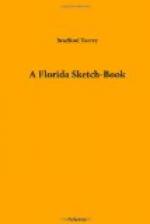On further acquaintance, let me say at once, Pucaea aestivalis proved to be a more versatile singer than the performances of my first bird would have led me to suppose. He varies his tune freely, but always within a pretty narrow compass; as is true, also, of the field sparrow, with whom, as I soon came to feel, he has not a little in common. It is in musical form only that he suggests the swamp sparrow. In tone and spirit, in the qualities of sweetness and expressiveness, he is nearly akin to Spizella pusilla. One does for the Southern pine barren what the other does for the Northern berry pasture. And this is high praise; for though in New England we have many singers more brilliant than the field sparrow, we have none that are sweeter, and few that in the long run give more pleasure to sensitive hearers.
I found the pine-wood sparrow afterward in New Smyrna, Port Orange, Sanford, and Tallahassee. So far as I could tell, it was always the same bird; but I shot no specimens, and speak with no authority.[1] Living always in the pine lands, and haunting the dense undergrowth, it is heard a hundred times where it is seen once,—a point greatly in favor of its effectiveness as a musician. Mr. Brewster speaks of it as singing always from an elevated perch, while the birds that I saw in the act of song, a very limited number, were invariably perched low. One that I watched in New Smyrna (one of a small chorus, the others being invisible) sang for a quarter of an hour from a stake or stump which rose perhaps a foot above the dwarf palmetto. It was the same song that I had heard in St. Augustine; only the birds here were in a livelier mood, and sang out instead of sotto voce. The long introductory note sounded sometimes as if it were indrawn, and often, if not always, had a considerable burr in it. Once in a while the strain was caught up at the end and sung over again, after the manner of the field sparrow,—one of that bird’s prettiest tricks. At other times the song was delivered with full voice, and then repeated almost under the singer’s breath. This was done beautifully in the Port Orange flat-woods, the bird being almost at my feet. I had seen him a moment before, and saw him again half a minute later, but at that instant he was out of sight in the scrub, and seemingly on the ground. This feature of the song, one of its chief merits and its most striking peculiarity, is well described by Mr. Brewster. “Now,” he says, “it has a full, bell-like ring that seems to fill the air around; next it is soft and low and inexpressibly tender; now it is clear again, but so modulated that the sound seems to come from a great distance."[2]




